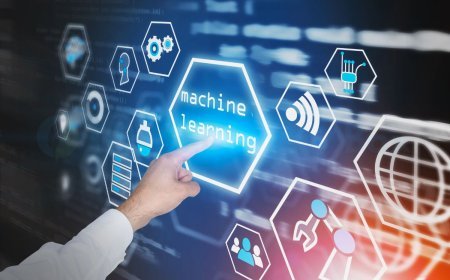What Is Training Data in Machine Learning: Essential Guide
Discover the purpose and definition of training data in machine learning. Gain insights from our essential guide on quality training datasets.

Have you ever wondered what exactly training data is in the realm of machine learning? Understanding this fundamental concept, along with machine learning algorithms, data science, analytics, and insights, is key to unlocking the potential of artificial intelligence. Training data serves as the foundation upon which machine learning models are built, enabling them to recognize patterns and make accurate predictions.
Curious to delve deeper into this crucial aspect of machine learning analytics, data analysis, insights, and data processing? In our upcoming discussion, we will explore the significance of training data, its role in shaping intelligent algorithms, and how it influences the accuracy and reliability of AI systems. Stay tuned for valuable insights on analytics, machine learning algorithms, data analysis, and strategies that will enhance your understanding of this essential component in the world of artificial intelligence.
Key Takeaways
-
Understanding Training Data: Training data is crucial in machine learning as it is used to teach algorithms how to make predictions or classifications.
-
Quality Matters: Prioritize feature selection, reliability, and strategies over quantity when sourcing training data to ensure accurate model performance.
-
Balancing Training and Testing Data: Distinct datasets are needed for training and testing to evaluate model effectiveness properly.
-
Sourcing Reliable Data: Partner with reputable sources or consider data labeling services to ensure the accuracy of training data.
-
Scaling Operations: As data needs grow, consider scaling data operations efficiently to handle increasing quantities effectively with strategies for storage and analytics.
-
Improving Outcomes: Implement strategies like feature engineering or hyperparameter tuning to enhance model performance and achieve better results.
Training Data Defined
Core Concepts
Training data in machine learning refers to the dataset used to train a model. It is crucial as it enables the model to learn patterns through data analysis and make predictions. The quality of training data directly impacts model accuracy.
The dynamic nature of training data is essential for models to adapt to real-world changes. As new information becomes available, the training dataset needs updates to ensure the model's predictions remain relevant and accurate.
Labeling Basics
Labeling data involves assigning tags or categories to each piece of information in the training dataset. In supervised learning, labeled data is fundamental as it provides the model with examples to learn from and make predictions accurately.
The process of labeling impacts model performance significantly. Well-labeled data enhances the model's ability to generalize patterns and make accurate predictions, while poorly labeled data can lead to erroneous conclusions.
Human Involvement
Humans play a crucial role in preparing and refining training data. They are responsible for tasks such as cleaning, annotating, and verifying data quality before feeding it into machine learning algorithms.
The "human in the loop" concept highlights the ongoing involvement of humans in supervising and improving machine learning models' performance in data processing, data analysis, and data quality. This iterative process ensures that models continuously learn from new data and improve their predictions over time.
Utilizing Training Data
Machine Learning Applications
Machine learning applications across various industries heavily rely on training data to enhance algorithm performance. By utilizing input data, these algorithms can effectively analyze and predict outcomes in fields such as healthcare, finance, marketing, and AI applications. The use of text data and video data allows for more diverse and accurate predictions.
Industries like healthcare benefit from machine learning by analyzing patient data to predict disease outcomes. In finance, fraud detection systems use training data to identify unusual patterns in transactions. Marketing companies utilize training data to personalize customer experiences based on past behaviors.
Dataset Implementation
Implementing training data into machine learning models involves preprocessing steps to clean and prepare the dataset for training. Handling missing values in data processing is crucial to ensure the accuracy of the model's predictions. By removing or imputing missing values, the dataset becomes more robust for training.
Data preprocessing before model training involves tasks like normalization, encoding categorical variables, and handling outliers. These steps ensure that the model can learn effectively from the dataset without being influenced by noise or irrelevant information. The size of the dataset also plays a significant role in determining how well a model performs.
Training vs Testing Data
Key Differences
Supervised learning involves labeled data, guiding the model during training, while unsupervised learning uses unlabeled data to identify patterns independently. Hybrid machine learning models leverage both approaches for enhanced accuracy and flexibility. The presence of labels significantly impacts model training by providing clear guidance in supervised learning, whereas unsupervised learning relies on inherent structures within data for insights.
Application Scenarios
Real-world scenarios showcase the significance of training data in machine learning, such as predictive maintenance in manufacturing using historical equipment performance data. Customizing training data ensures tailored solutions for specific applications, like personalized recommendations in e-commerce based on user behavior patterns. Training data's versatility shines across various domains, from healthcare diagnostics to financial fraud detection.
Sourcing Training Data
Acquisition Methods
To acquire training data for machine learning, there are various methods available, including images from the cloud and active techniques. One common approach is manual data collection, where individuals manually gather and label data. This method ensures precision but can be time-consuming. Conversely, automated data acquisition techniques involve using web scraping tools or APIs to collect large datasets efficiently. These methods save time but may lack the accuracy of manually curated data.
When acquiring training data, data diversity plays a crucial role in creating comprehensive datasets. Diverse datasets ensure that machine learning models can generalize well to new, unseen data. By incorporating a wide range of examples across different categories and variations, the model becomes more robust and capable of handling real-world scenarios effectively.
Public vs Private Sources
Differentiating between public and private sources of training data is essential in machine learning. Public sources offer readily available datasets that are often free to access. However, these datasets may lack quality control and could contain errors or biases. On the other hand, private sources provide curated and high-quality data but may come at a cost.
Considering the advantages and challenges associated with each source is crucial when choosing training data. Public sources offer a vast amount of data for experimentation and research purposes, but verifying its reliability is necessary. Private sources ensure data quality but may limit the accessibility of certain datasets due to proprietary restrictions.
When deciding between public and private training data, considerations such as data integrity, relevance to the specific use case, scalability requirements, and budget constraints should be taken into account to select the most suitable option for the machine learning project.
Data Quantity Requirements
Determining Needs
To determine the specific training data requirements for machine learning, begin by outlining the data features crucial for the model. Consider the variety, volume, and velocity of data needed. Assess the diversity and representativeness of the dataset to ensure comprehensive coverage.
When selecting training data sources, factor in their relevance, accuracy, and completeness. Ensure that the data is free from biases and errors that could skew model outcomes. A mix of structured and unstructured data may be necessary based on the project's objectives.
To assess the adequacy of training data, establish a framework that includes evaluating the size of the dataset, its labeling quality, and the presence of any outliers or missing values. Utilize tools like statistical analysis and visualization techniques to gain insights into data characteristics.
Impact on Model Performance
Training data quality directly influences model performance; therefore, ensuring high-quality data is paramount. The correlation between training data quantity and model accuracy is significant; a larger, diverse dataset often leads to more robust models with better generalization capabilities.
Refining training data is an iterative process involving continuous evaluation, cleansing, and augmentation. By identifying and addressing inconsistencies or biases in the dataset, model performance can be enhanced significantly. Regularly updating training data based on feedback loops improves model adaptability over time.
Quality Over Quantity
Factors Influencing Quality
People
Skilled individuals play a crucial role in handling training data for machine learning. Data scientists, engineers, and analysts are essential for ensuring the quality of training data. Collaboration between these roles is vital in optimizing training data for accurate model predictions.
Process
The systematic process of handling training data involves stages like data preparation, labeling, and model training. Data preparation includes cleaning and formatting data, while labeling assigns meaningful tags to datasets. Model training refines algorithms based on labeled data, emphasizing an iterative approach for continuous improvement.
Tools
Essential tools for managing training data include data annotation tools and platforms for organizing datasets. Data annotation tools streamline the labeling process by enabling efficient tagging of large datasets. Data management platforms assist in structuring and storing vast amounts of training data for easy access and retrieval.
Quality Assessment Techniques
Exploring techniques to assess the quality of training data is crucial for reliable machine learning models. Identifying and rectifying errors in data labeling ensures high-quality inputs for model training. Quality assurance processes such as outlier detection and high correlation filters help maintain the integrity of training datasets.
Scaling Data Operations
Managed Teams Benefits
Utilizing managed teams for training data tasks offers numerous advantages. These teams bring expertise and efficiency to the data collection process. With managed teams, companies can ensure accuracy and reliability in their training datasets.
Managed teams streamline the training data process by providing structured workflows and clear guidelines. This ensures that data collection is done systematically and according to specific requirements. The oversight of these teams helps in maintaining consistency and quality throughout the dataset.
Expert oversight in managing training data quality is crucial. Managed teams can identify and rectify errors promptly, ensuring that the dataset remains reliable. Their supervision also aids in detecting any biases or anomalies, contributing to more accurate machine learning models by improving data quality and data analysis.
Crowdsourcing Limitations
Despite its popularity, crowdsourcing comes with limitations for training data collection. One significant challenge is related to data quality. Crowdsourced datasets may contain errors due to varying levels of expertise among contributors. This can impact the overall performance of machine learning models due to data quality and ai.
Another limitation of crowdsourcing is consistency. Different contributors may interpret tasks differently, leading to inconsistencies in the labeled data. This inconsistency can introduce noise into the dataset, affecting the model's ability to generalize effectively.
When deciding on using crowdsourcing for training data, it's essential to consider factors such as task complexity, budget constraints, and project timelines. While crowdsourcing can be cost-effective and fast, ensuring data quality and consistency may require additional resources for verification and cleaning processes.
Partnering for Data Labeling
Selecting a Partner
When choosing a partner for training data services, consider their experience and expertise in the field. Look for partners with a proven track record in accurately labeling data. Compatibility with your project goals and timelines is crucial for seamless collaboration.
Ensure the partner can handle various types of data and formats relevant to your project. Evaluate their quality control processes to guarantee accurate annotations. A reliable partner should offer flexibility to accommodate changing project requirements efficiently.
Consider the scalability of the partner's operations to meet your future needs as your project grows. Look for partners who prioritize data security and confidentiality to protect sensitive information. Effective communication and transparency are essential for successful collaboration.
Quality Assurance Questions
Ask partners about their annotation guidelines and quality control measures. Inquire about the tools and technologies they use to ensure data accuracy. Discuss how they handle edge cases and ambiguous data points during the labeling process.
Verify the consistency of annotations across different annotators within the partner's team. Request samples of previously labeled data to assess quality standards firsthand. Create a checklist outlining specific quality assurance criteria tailored to your project requirements.
Implement regular audits and reviews of annotated data to maintain quality standards throughout the project. Collaborate closely with the partner to address any discrepancies or issues related to data quality promptly. Establish clear feedback loops to continuously improve data labeling accuracy.
Outcome Improvement Strategies
Quality Data Benefits
High-quality training data is crucial in machine learning for achieving accurate and reliable model predictions. When the data used to train a model is of high quality, it results in more precise outcomes. Investing in quality training data ensures that the model can effectively learn patterns and make informed decisions.
The benefits of using high-quality training data extend beyond immediate improvements in model performance. By feeding the model with accurate and relevant data, organizations can enhance their decision-making processes, leading to better business outcomes. quality data enables models to adapt to new scenarios and challenges effectively.
Continuous Improvement Process
In the realm of machine learning, continuous improvement in training data is an iterative process that involves refining and enhancing the dataset over time. Feedback loops play a critical role in this process by allowing organizations to incorporate new information and adjust existing data points. By continuously updating and optimizing the training data, models can evolve and improve their accuracy.
Ongoing data analysis is essential for monitoring model performance and identifying areas for enhancement. Through regular evaluations of the training data, organizations can pinpoint weaknesses or biases in the dataset and take corrective actions. This continuous monitoring ensures that models remain robust, adaptive, and maintain data quality to changing conditions.
Closing Thoughts
As you navigate the realm of training data in machine learning, remember that quality surpasses quantity. Your focus should be on sourcing reliable data and ensuring its accuracy for optimal model performance. Partnering with experts for data labeling can streamline your operations and enhance outcomes significantly. Remember, scaling your data operations strategically is key to success. Embrace a quality-centric approach, prioritize outcome improvement strategies, and always seek ways to refine your training data processes. Take action today to elevate your machine learning endeavors!
Frequently Asked Questions
What is the importance of training data in machine learning?
Training data is crucial in machine learning as it is used to teach algorithms how to make accurate predictions or classifications. The quality and quantity of training data directly impact the model's performance and effectiveness in solving real-world problems.
How can one ensure the quality of training data for machine learning models?
Ensuring high-quality training data involves thorough data cleaning, preprocessing, and labeling processes. It's essential to identify and eliminate errors, outliers, and biases that could negatively impact the model's performance and data quality. Utilizing diverse sources and validation techniques also helps maintain data quality.
Why is it necessary to differentiate between training and testing data in machine learning?
Distinguishing between training and testing data is vital to evaluate a model's performance accurately. Training data is used to build the model, while testing data assesses how well the model generalizes to new, unseen data. This separation helps prevent overfitting and ensures reliable predictions.
How can one effectively scale data operations for machine learning projects?
Scaling data operations involves leveraging tools like cloud computing, distributed processing frameworks, and automation techniques. By optimizing workflows, utilizing parallel processing, and implementing efficient storage solutions, organizations can handle large volumes of data efficiently for training robust machine learning models.
Why is partnering for data labeling beneficial in machine learning projects?
Partnering with specialized companies for data labeling can expedite the process while ensuring high accuracy levels. These partners often have expertise in annotation tasks, access to skilled annotators, and quality control mechanisms that enhance the overall efficiency and reliability of labeled datasets.
What's Your Reaction?







































![MacBook Pro M5: All the features and specs you need to know [LEAKS REVEALED]](https://tomsreviewbox.com/uploads/images/202502/image_430x256_67bd6d7cd7562.jpg)



























